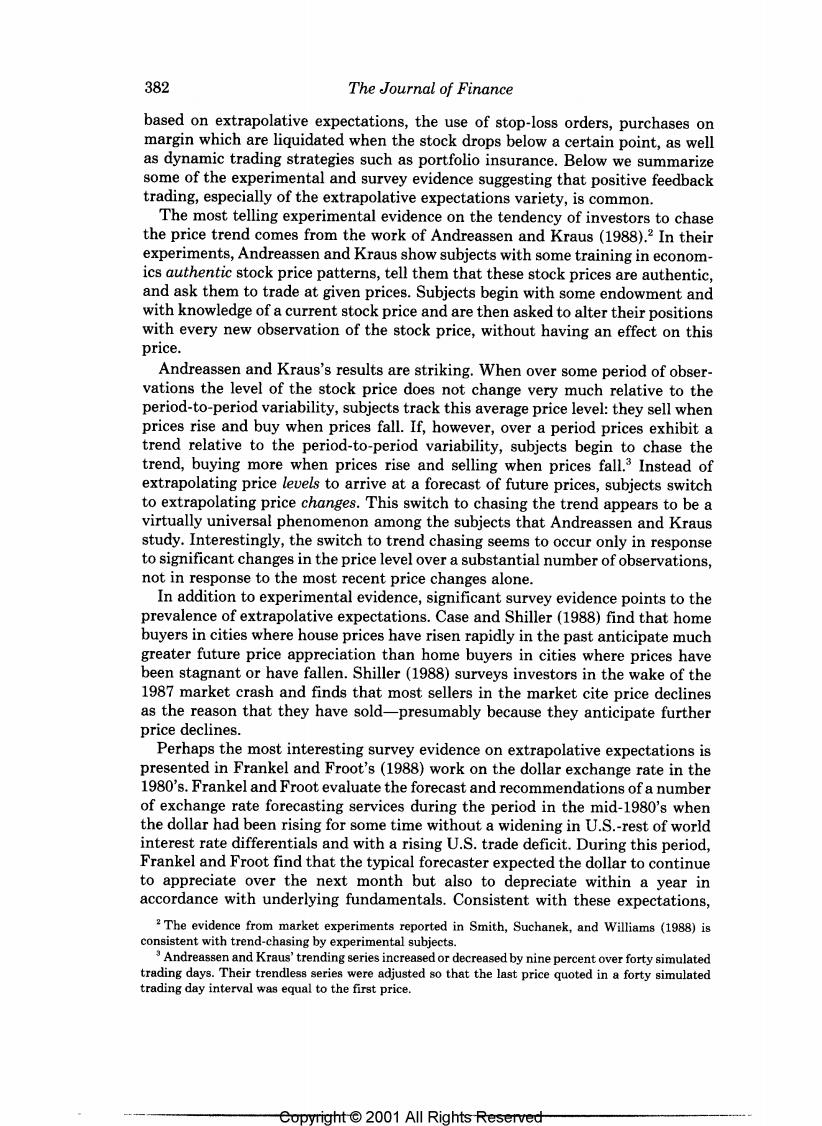正在加载图片...

382 The Journal of Finance based on extrapolative expectations,the use of stop-loss orders,purchases on margin which are liquidated when the stock drops below a certain point,as well as dynamic trading strategies such as portfolio insurance.Below we summarize some of the experimental and survey evidence suggesting that positive feedback trading,especially of the extrapolative expectations variety,is common. The most telling experimental evidence on the tendency of investors to chase the price trend comes from the work of Andreassen and Kraus (1988).2 In their experiments,Andreassen and Kraus show subjects with some training in econom- ics authentic stock price patterns,tell them that these stock prices are authentic, and ask them to trade at given prices.Subjects begin with some endowment and with knowledge of a current stock price and are then asked to alter their positions with every new observation of the stock price,without having an effect on this price. Andreassen and Kraus's results are striking.When over some period of obser- vations the level of the stock price does not change very much relative to the period-to-period variability,subjects track this average price level:they sell when prices rise and buy when prices fall.If,however,over a period prices exhibit a trend relative to the period-to-period variability,subjects begin to chase the trend,buying more when prices rise and selling when prices fall.3 Instead of extrapolating price levels to arrive at a forecast of future prices,subjects switch to extrapolating price changes.This switch to chasing the trend appears to be a virtually universal phenomenon among the subjects that Andreassen and Kraus study.Interestingly,the switch to trend chasing seems to occur only in response to significant changes in the price level over a substantial number of observations, not in response to the most recent price changes alone. In addition to experimental evidence,significant survey evidence points to the prevalence of extrapolative expectations.Case and Shiller(1988)find that home buyers in cities where house prices have risen rapidly in the past anticipate much greater future price appreciation than home buyers in cities where prices have been stagnant or have fallen.Shiller(1988)surveys investors in the wake of the 1987 market crash and finds that most sellers in the market cite price declines as the reason that they have sold-presumably because they anticipate further price declines. Perhaps the most interesting survey evidence on extrapolative expectations is presented in Frankel and Froot's(1988)work on the dollar exchange rate in the 1980's.Frankel and Froot evaluate the forecast and recommendations of a number of exchange rate forecasting services during the period in the mid-1980's when the dollar had been rising for some time without a widening in U.S.-rest of world interest rate differentials and with a rising U.S.trade deficit.During this period, Frankel and Froot find that the typical forecaster expected the dollar to continue to appreciate over the next month but also to depreciate within a year in accordance with underlying fundamentals.Consistent with these expectations, 2 The evidence from market experiments reported in Smith,Suchanek,and Williams (1988)is consistent with trend-chasing by experimental subjects. Andreassen and Kraus'trending series increased or decreased by nine percent over forty simulated trading days.Their trendless series were adjusted so that the last price quoted in a forty simulated trading day interval was equal to the first price. Copyriaht 2001 All Riahts Reserved